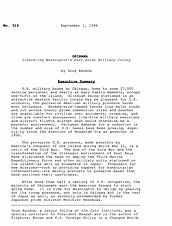The pervasive U.S. presence, made possible by America’s conquest of the island during World War II, is a relic of the Cold War. The end of the Cold War and the transformation of the strategic environment of East Asia have eliminated the need to deploy the Third Marine Expeditionary Force and other military units stationed on the island–as well as elsewhere in Japan. Proposals for new missions–such as providing support for humanitarian interventions–are merely pretexts to preserve bases that have outlived their usefulness.
After more than half a century of U.S. occupation, the majority of Okinawans want the American troops to start going home. It is time for Washington to oblige by phasing out its troop presence, not only in Okinawa but in the rest of Japan as well, as recently recommended by former Japanese prime minister Morihiro Hosokawa.


